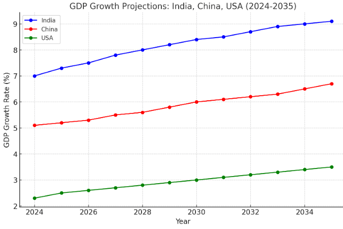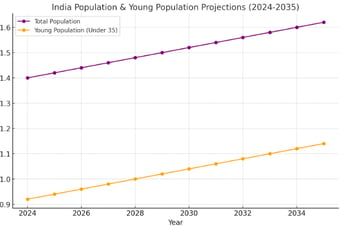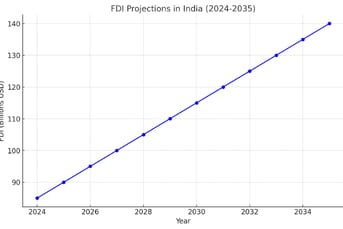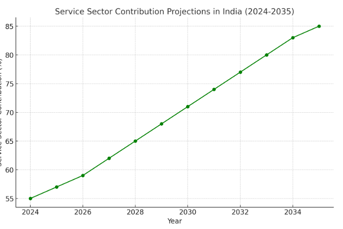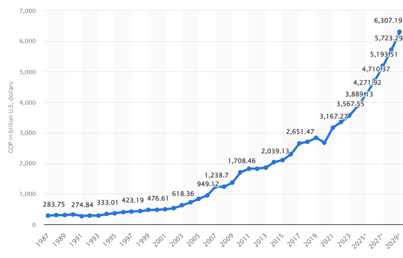India - On growth Trajectory for Next Decade
WORLD ECONOMIC NEWS
www.wealthymatter.com
3/30/20255 min read


India – On Growth Trajectory in coming Decade
India has been navigating the path of economic evolution for decades. In the last few years, it has been steadily progressing towards becoming one of the largest economies worldwide, with forecasts suggesting that it may rise to the position of the world's third-largest economy by 2030. India is not merely a regional powerhouse in Asia; it is swiftly transforming into a global financial engine with the potential to steer the course of the world’s economic future.
India’s Present Economic Climate
In 2023, India has already overtaken China to become the most populous nation on the planet. With a population exceeding 1.4 billion, it stands as a vast consumer market and workforce. This demographic edge is one of India's most compelling attributes. Coupled with swift urbanization and a burgeoning middle class, India is solidifying its role as a significant player in international markets. The International Monetary Fund (IMF) projects that India’s GDP growth rate will remain robust, even amid stagnation in global growth rates.
The graph displayed above illustrates the comparison of India’s GDP growth rate with those of other leading economies. It is evident that India is at the forefront, with a projected GDP growth rate of 7% for 2024. This figure markedly surpasses those of other major nations, including China (5.1%), the United States (2.3%), Germany (1.9%), and Japan (1.7%). This remarkable growth trajectory emphasizes India’s rising prominence in the global financial sphere. Projected GDP in USD expected to reach 6.3 Trillion USD in 2029.
Key Factors Driving India’s Economic Growth
Demographics and Young Workforce
India boasts a youthful demographic, with over 65% of its population under the age of 35. This demographic dividend grants India a noteworthy advantage, as a substantial portion of the populace is of working age. The labor force is on the rise, and with advancements in education, skills training, and technological development, India is cultivating a workforce that is proficient in meeting the requirements of the contemporary economy.
Technological Progress and Innovation
India’s information technology sector has emerged as a global success, with leaders like Infosys, TCS, and Wipro paving the way. Recently, India has established itself as a frontrunner in sectors including fintech, e-commerce, and artificial intelligence. The rapid uptake of digital technologies and the extension of internet access to rural regions are reshaping India’s economic landscape, birthing new business models and avenues for growth.
Government Initiatives
The Indian government has rolled out a variety of initiatives to stimulate economic development, such as “Make in India,” “Startup India,” and “Digital India.” These programs aim to enhance manufacturing, foster entrepreneurship, and promote technology-driven advancement. Furthermore, the government has prioritized infrastructure development, including the construction of new highways, enhancement of ports, and improved connectivity in rural areas.
Foreign Direct Investment (FDI)
India ranks among the foremost choices for FDI. The United Nations Conference on Trade and Development (UNCTAD) reported that India attracted over $83 billion in FDI in 2022, a clear sign of global confidence in its economic trajectory. The government's initiatives to simplify business regulations and introduce reforms like the Goods and Services Tax (GST) have significantly contributed to the influx of international investment.
India’s Position as a Global Financial Growth Engine
India's ascendance as a financial powerhouse is also linked to the expansion of its financial services sector. From banking to insurance, asset management to venture capital, India is broadening its financial presence swiftly. Indian stock markets, such as the Bombay Stock Exchange (BSE) and the National Stock Exchange (NSE), have consistently achieved new milestones, with the country’s stock market capitalization now ranking among the top 10 globally.
Moreover, India is evolving into a hub for venture capital and private equity investments, particularly in domains like fintech, health tech, and renewable energy. These industries are not only bolstering the nation’s GDP growth but are also generating significant opportunities for global investors seeking high-growth markets.
Contrasting India with China
In assessing India against its nearest competitor, China, several notable distinctions come to light:
Demographics: While both nations boast large populations, India’s younger demographic presents a significant advantage in terms of a growing labor force. In contrast, China’s aging population poses long-term challenges for its economy.
Economic Growth: India’s GDP growth rate has outpaced China’s in recent years, particularly following China’s economic deceleration due to underlying structural issues. The youthful demographic, rising urbanization, and domestic consumption in India are propelling its economic engine.
Political Environment: China’s political framework is centrally governed by the Communist Party, whereas India operates as the world’s largest democracy. This political freedom nurtures greater innovation, entrepreneurship, and consumer choice, evident in India’s flourishing startup culture.
Political Landscape : The political scene in China operates under stringent control of the Communist Party, in stark contrast to India, which stands as the largest democracy globally. This political liberty fosters greater creativity, entrepreneurship, and choices for consumers, which are evident in India's flourishing startup ecosystem.
Production vs. Services: China has historically dominated in manufacturing, while India's strengths are found within its service industry, especially in sectors like information technology, finance, and e-commerce. With the global trend shifting towards services, India is set to gain substantially.
The Way Forward:
Challenges and Possibilities
Even with its vast potential, India encounters numerous challenges. These encompass disparity in income, shortcomings in infrastructure, bureaucratic obstacles, and intricate political landscapes. Nonetheless, these issues are not beyond resolution, and India is proactively working to tackle them via reforms and investments in human resources.
In the years to come, India is positioned to become a focal point in the global economic dialogue. Its swiftly growing middle class, resilient consumer market, and growth driven by innovation render it an enticing opportunity for international investors. If it continues to progress in enhancing infrastructure, education, and governance, India will undoubtedly cement its status as the forthcoming global economic engine and superpower.
Conclusion:
India’s economic journey is unstoppable . With its youthful demographic, strong economic advancement, and growing financial sector, India is ready to play a significant role in fueling global financial growth in the upcoming decades. As the world transitions toward a multipolar economic framework, India is establishing itself as a key player in molding the global financial environment. Consequently, India’s rise not only serves its own populace but also benefits the entire world, heralding a novel chapter of global economic prosperity.
